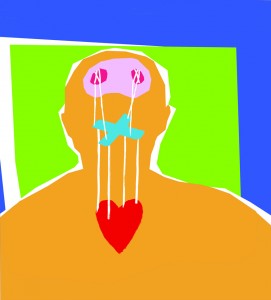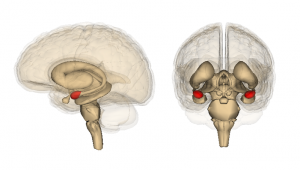SATURDAY, 29 JANUARY 2011
How do we know our mum is our mum? What does it mean to have ‘déjà vu’ and what makes us gaze in wonder at our surrounding universe? The answer may lie in a small part of the brain called the amygdala. An almond shaped region sitting close to the hippocampus, the amygdala has numerous vital neurological roles, which include interpreting social signals and controlling emotional responses. It is also thought to be involved in providing a sense of self. Such correlative examples merely skim the surface of the amygdala’s functions, many of which we still do not know.When primate amygdalas were experimentally severed it was found that they were no longer able to respond to social cues, became withdrawn and, critically, lost their previously held positions in the social group hierarchy.
Just like monkeys, human society operates through social hierarchies. As group sizes grew in our ancestral apes, so did the evolutionary drive for social behaviours and thus the development of associated brain regions, including the amygdala. One of the vital traits that resulted from this development was the ability to empathise.
The ability to imagine oneself in another’s place is generally thought to be unique to humans and requires complex neurological processes. This includes the ability to associate significance to the behaviour of others, which means, for example, being able to appreciate instinctively what makes a laugh nervous, a glance stern, a gaze loving or a smile fake and to understand the driving force behind why another displays such behaviour. It then requires the association of an adequate response to that behaviour, such as suspicion, fear, anger or laughter. The part of the brain correlated with these functions is once again the amygdala.
Research into human sociability has shown links between the amygdala and autism, one of our most well-known social syndromes. Experiments, such as that conducted by Cambridge professor Simon Baron-Cohen, demonstrate that autistic individuals find it difficult to judge emotions from looking at eyes, a task which neurotypicals find generally easy. These experiments suggest that an impairment of the amygdala could be a cause of the social difficulties characteristic of autism.
However, what if someone wasn’t born with a defective amygdala but instead it was damaged later in life? This can happen as a result of a stroke, causing victims to develop some startling symptoms. For example, sufferers of Capgras syndrome often become convinced that their loved ones have been replaced by impostors, robots or abducted and replaced with aliens. The emotional ‘glow’ which normally flares in the brain at the sight of a loved one is suddenly absent. In order to resolve the cognitive dissonance the brain concludes, quite incredibly, that they are not truly their loved one but are instead an impostor. This has had tragic results, such as one man who murdered and cut open the skull of his own father to try and find the robotic computer ship he was certain would be found there. Cotard’s syndrome is a similar disorder where sufferers become convinced that they are dead and sometimes even claim to be able to smell their own rotting flesh. This may be because they no longer experience any emotional significance, due to a dysfunctional amygdala, and the phantom scent may be because the amygdala is intimately involved in smell. Without the ability to associate significance to anything, patients live in a dull emotionless world and thus become convinced they must be dead.
While it may seem hard to imagine the experiences of Capgras and Cotard’s syndrome sufferers, the amygdala is also associated with déjà vu, a familiar feeling to most human beings. Déjà vu is thought to occur when the connection between adding and recalling significance from the past gets mixed up with the present, giving us the feeling of re-experiencing a familiar situation. ‘Jamais vu’ is the opposite—although much rarer—experience in which a familiar situation suddenly seems alien as the normal ‘significance’ messages fail to flair. Such experiences give us a small insight into what it might feel like to experience amygdala malfunction.
An individual who constantly observes significance in every aspect of life, who has heightened emotions, is deeply religious and possesses an increased sense of self importance may have a type of epilepsy that is once again connected to a dysfunctional amygdala. The most widely recognised form of epilepsy occurs when neurones in the brain start firing uncontrollably, causing a mass of excitatory behaviour through the brain, leading to whole bodily convulsions (a grand mal seizure). However, seizures can sometimes stay localised in a particular brain region and for these individuals the seizures affect the temporal lobe. This is referred to as temporal lobe epilepsy (TLE). Such seizures originate in the amygdala before spreading to other areas of the brain.
When TLE sufferers have seizures, they often describe having highly spiritual experiences, saying such things as “the world makes sense now” and “I finally understand the true nature of the cosmos.” Each time they have a seizure that spreads to a certain area of the brain, the threshold of electrical activity needed to activate that area becomes a little lower. If it gets low enough, a person will find themselves consistently having the experiences associated with that brain region.
So, if a person’s seizures include a heightened spiritual experience, they may then start to see spirituality all around them, all the time. Indeed, even healthy people whose temporal lobes are stimulated using a transcranial magnetic stimulator often claim to have a spiritual experience. Consumer demand has blossomed as result, with individuals being sold gear such as the ‘eight wheel shakti’ and ‘god helmet’ which controversially claim to offer purchasers spiritual experiences.
But what is it about the temporal lobe that causes such spiritual phenomena? Well, as the amygdala evolved to be responsible for attaching emotional significance to people, actions and events, it is easy to imagine that, as a preadaptative offshoot, it started projecting significance onto other things such as the weather, geographical landscapes, animals and trees. Indeed, humans have been fascinated by these aspects of our world for thousands of years, often anthropomorphising them. Temporal lobe epileptics simply experience such attribution of significance in excess and begin to see symbolism in everything.
Perhaps what we know as spiritualism and what we see as our imperative to understand and explain the world may have been catalysed by our evolutionary need to understand each other. It is this development that may have been the driving force that allowed ancestral humans to dominate over the other contemporary bipedal hominids. Although Neanderthals may have had bigger brains than humans, they did not develop cultural practices and rituals of comparable complexity. It is speculated by some that they may not have had, for instance, the ability to associate complex meaning to art, music, birth, or death. It was perhaps this ability to attribute significance to our lives that helped humans become spiritual, insightful and innovative, and consequently survive, while Neanderthal populations became extinct.
Sociability, spirituality, culture and the maintenance of a sense of self—correlated with such an array of functions, the importance of the amygdala and its role in the attribution of significance is evident. With so many of these factors associated with human intellect and cultural sophistication, it seems that studying the amygdala will be crucial in our search for what it means to be human.
Annabelle Painter is a 2nd year undergraduate in the School of the Biological Sciences



